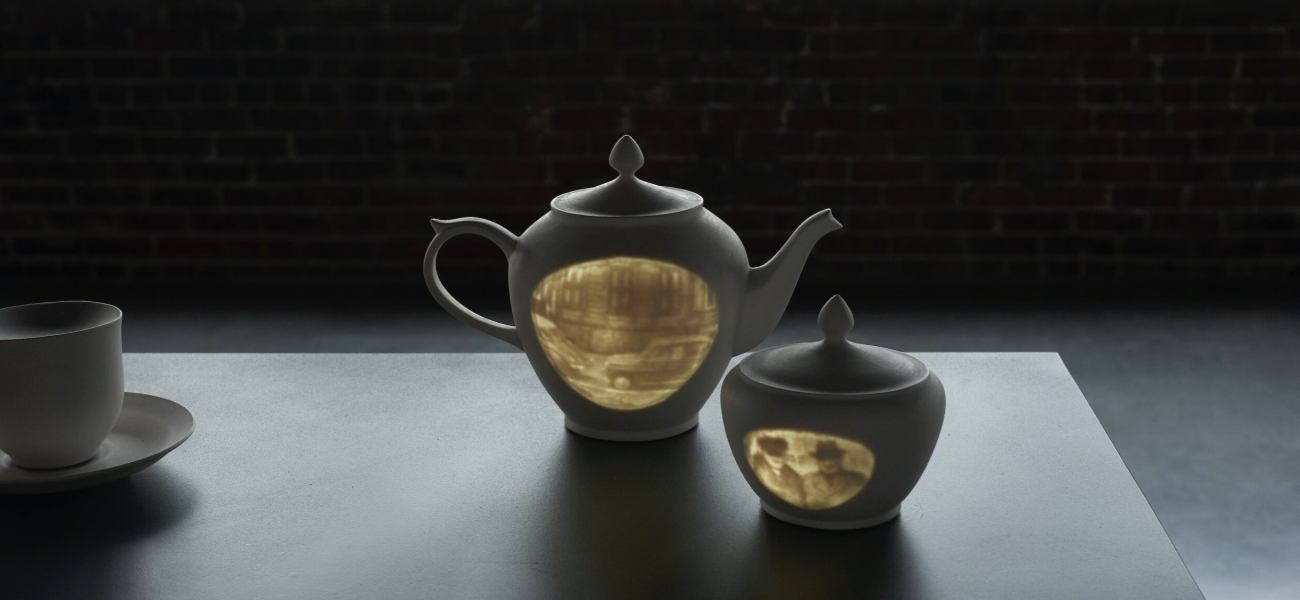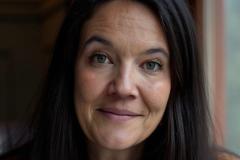Silent Witness
The central dangers confronting our coming century are in the conversation of "one without the other," dialogue that continues to propagate linear narratives, and conversations that singularly memorialize the vulnerable while encasing historic moments in the blinding shroud of "that will never happen again."
This mind-set can translate through all genres of human culture; policing, mental health, politics, and art. It's an easy cycle to get swept up in, and in truth, I found myself in this unconscious bias before encountering Rae Stern and her exhibition In Fugue.
For context, we must start with the Holocaust and my intention to bring readers a reflective article on memorial art. I interviewed Rae Stern on Monday, October 3rd, 2022, but in my quest to reflect on a time "that will never happen again," Rae – so purposefully, so sincerely – developed a parallel narrative; a soft but urgent rallying cry about the need for us to come together.
Rae Stern: "When we tell that story of persecution, we often focus on the moments where people are most vulnerable. That vulnerability can create, I think, a gap of denial. An informal or passive way of saying, 'Oh, that's them. That's not something that could happen to me.'"
When I recall the academic memories stored in my mind's eye of learning about the Holocaust, there is no hesitation for my mind to deliver images of tragedy. I associate these images with crime scenes and the desire to prevent this type of persecution from happening in my lifetime. But it's true, I also see this as an act of genocide, and the victims are survivors of something so complex that I do not inherently relate to their experience. I can empathize and imagine, but no experience I have ever been exposed to can truly place me in the context of profoundly feeling what it was like to endure or survive the Holocaust.
We all seem to see ourselves as strong in one form or another. In our day-to-day lives, even if we feel less than powerful, we have autonomy. But to be victimized is truly a loss of ownership, a complex and confusing moment forced upon you. It's hard to imagine such a loss of control, and we all seem to want to lean on "It wouldn't happen to me," "I would fight," or "I would XYZ – insert preferred excuse." I think we fear this type of weakness, and our minds protect us from truly relating to it. Instead, it is easier to memorialize, honor, reflect, and say, "We will not let this happen again."
In this memorialized act, we unintentionally freeze people in their victimhood. We keep the narrative linear; an understandable sequence of events that we promise "we will never let happen again." History books and memorial museums hold us in and warn us of the concepts of trauma, but what of contemporary practices and truthful counterpart narratives of these same events?
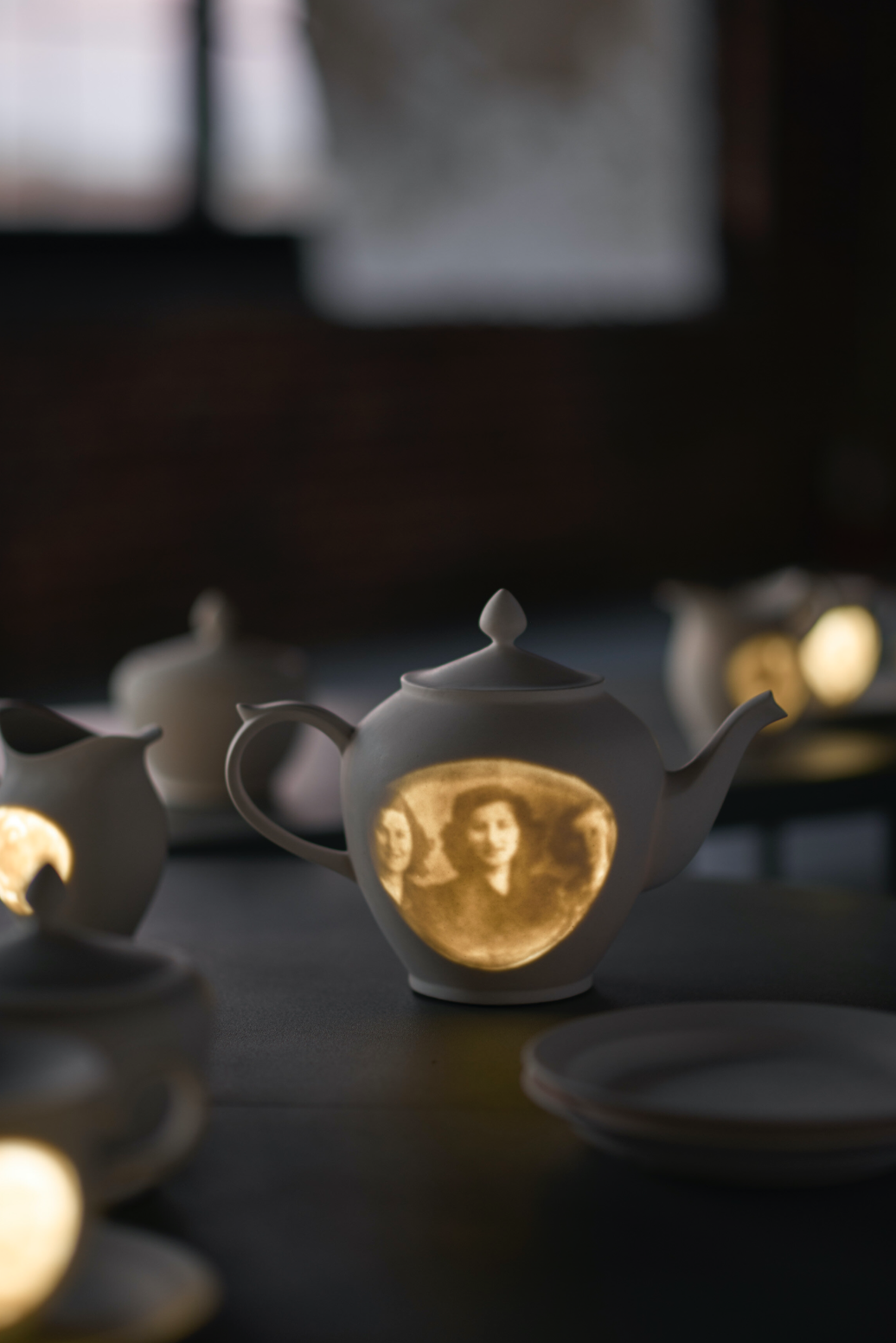 Rae: "It was important for me to show that these people were just like you and me. A few weeks, a few months prior, they were living their lives, loving each other, arguing; children were growing and were doing typical funny things. I wanted to bring that sense of normalcy that I feel is much more important for us if we intend to relate. Not just something that happened in history to people that we can't relate to, but something that can happen to anyone. And sadly, it is actually happening currently around the world.”
Rae: "It was important for me to show that these people were just like you and me. A few weeks, a few months prior, they were living their lives, loving each other, arguing; children were growing and were doing typical funny things. I wanted to bring that sense of normalcy that I feel is much more important for us if we intend to relate. Not just something that happened in history to people that we can't relate to, but something that can happen to anyone. And sadly, it is actually happening currently around the world.”
While dealing openly with the past faults of society is critical and necessary, Rae has a soft urgency to her tone as she communicates the need to diversify the narrative beyond memorial art. Through her art, she is actively challenging the underrepresentation of how people have been characterized.
Rae: “It comes back to our original conversation about memorializing things. When we're only looking at people in their vulnerable moments, not them as multifaceted humans with complex human experiences, we are not necessarily relating and identifying with their vulnerability but adding to the trauma narrative that had grouped them and stripped them of their individuality. The conversation is not just about getting access to a memorial museum but also about reframing that narrative so that it's more diverse. This missing part of the conversation is absolutely an invaluable part of that discussion.
"We have to be responsible with how we bring back memories and recollections, and we have to consider that recollection is more ambiguous than we would like it to be. Specifically, in my exhibition In Fugue, I reframed the historical perspective with the choice of photographs and the desire to make that imagery accessible.
"Rather than focusing on the historic aspects that could make the work look very early 20th century – the hairstyle, background, and things of that sort – I reduced era-specific details and tried to crop the portraits right down to the faces. So, the focus is on the expression rather than the styling of that person. Rather than anchoring that person in a different time period or context of trauma, I wanted the audience to experience their humanity.
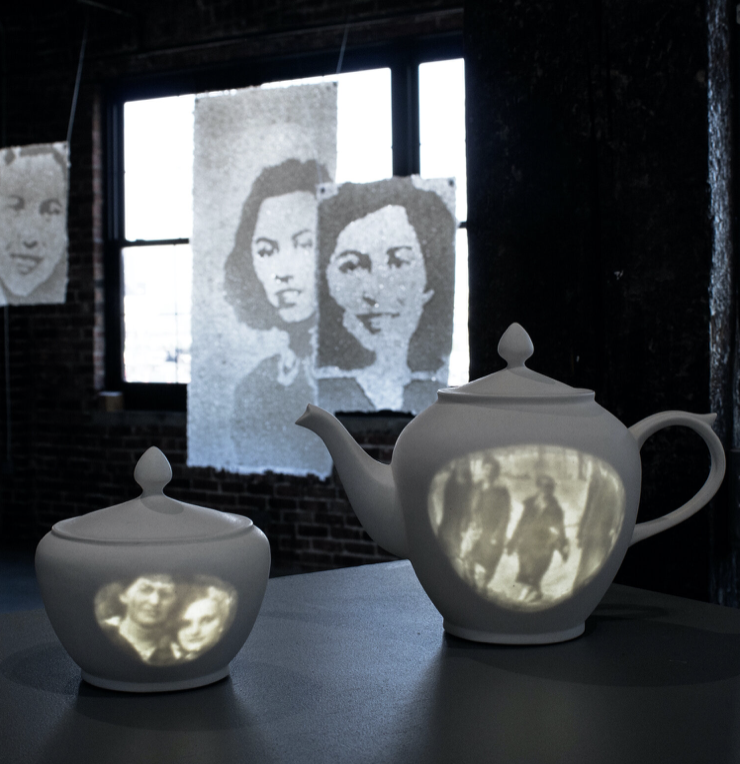 "There's a universality to the work because I'm presenting images of happier times that most people can relate to universally. It's not those vulnerable moments. We can all relate to having a joyful experience: graduation, holidays, brides and grooms, being with friends, and having our portraiture taken. And I was wondering about the idea of collective knowledge of those styles of images. They're not unique to one person; it's not one singular person's experience. Obviously, it's one person in the photo, but in that individuality, it's also a collective memory. It's a universal experience. Regardless of what society we come from or who we are, there are elements in our lives that repeat themselves; we go through these milestones as humans. I wanted to play with that tension between the individual – between the really personal story – and how it is part of a greater story of humanity."
"There's a universality to the work because I'm presenting images of happier times that most people can relate to universally. It's not those vulnerable moments. We can all relate to having a joyful experience: graduation, holidays, brides and grooms, being with friends, and having our portraiture taken. And I was wondering about the idea of collective knowledge of those styles of images. They're not unique to one person; it's not one singular person's experience. Obviously, it's one person in the photo, but in that individuality, it's also a collective memory. It's a universal experience. Regardless of what society we come from or who we are, there are elements in our lives that repeat themselves; we go through these milestones as humans. I wanted to play with that tension between the individual – between the really personal story – and how it is part of a greater story of humanity."
While photographic evidence has laced our understanding of the Holocaust, the images are often categorized in archives and records, feeling more akin to evidence than material for art. Rae, on the contrary, has gathered photographs that, while distinctively individual, are also universal devices that activate collective or shared experience.
It is in the combination of Rae's hybrid materiality: reframed photography, the transparency of porcelain, the illuminance of lithophanes, and the heirloom – almost mundane – nature of tea sets that she creates a contemporary narrative that drifts in the arena of magical realism.
Before I get too far ahead, I want to caution that I'm not fond of the word magic, especially as it relates to ceramics. Magic is too often used to undermine the labor and physically demanding work that most studio ceramists experience. I hear it too often in relation to atmospheric firings when people get lucky and want to avoid thescience – and sheer labor – of flame meeting clay. It's not magic; it's work – hard work. Hard work that the artist has failed at and come back to time and again to master their process. The magic – if any – is the seamlessness, the fantastical and the surreal combination of hours of research, labor, failure, and subsequent success in a singular work of art.
Rae's work is a bold testament to research, collaboration, and hours served in the quest for a flawless union of concept and objectness. Her research on lithophanes began during her collaboration with Aya Margulis as Doda Design, following their graduation from the industrial design master’s program at the Bezalel Academy of Art and Design in Jerusalem. Lithophanes are designed to be backlit, yet Rae and Aya's proprietary process and the hand-sanded surfaces show none of the bumpy exterior facades the process is known for. Further adding to the technical complexity is the invisible time-based technology that softly illuminates the porcelain forms from within. Rae worked with Craig Berscheidt to fabricate digital units with sensors that activate LED lights. All of which is to say that this technology, hardware, and coding are invisible to the audience's eye. One would never be aware that any of this exists upon first glance – or even second glance – of the exhibition. I will leave the description of Rae's process as a gentle teaser to simply state that it's not magic but masterful work. The genuine enchantment is in the seamless perfection hidden within
her design.
Though they seem commercial and readily available, the tea sets are a custom design unique to Rae's sketches and 3D CAD modeling.
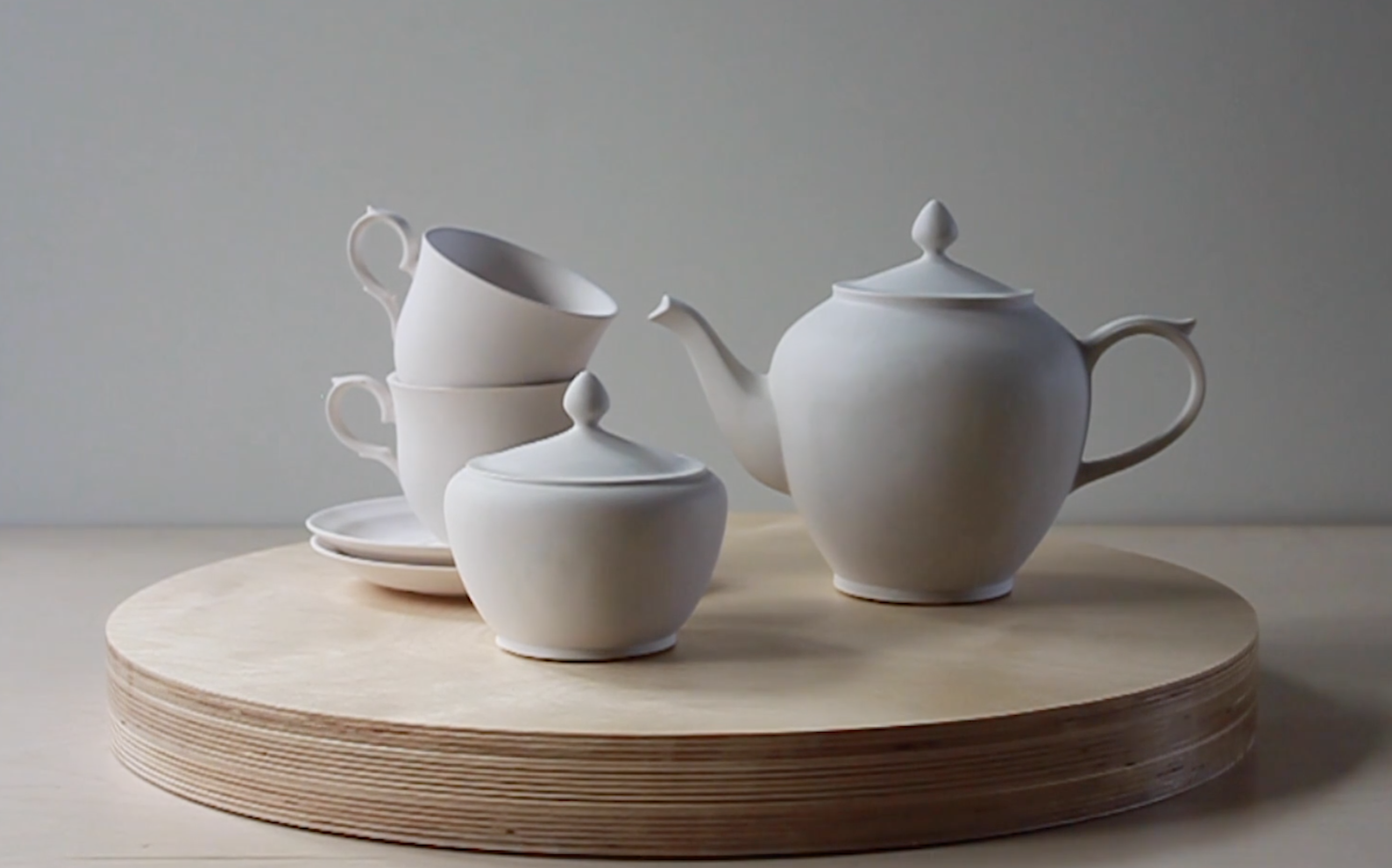
Rae: "Like we were saying about universality, the tea set is a kind of continuum of objects, forms, and shapes that we are all uniquely and individually familiar with. We can see them across cultures and disciplines; they universally register and make sense to us. And I think, again, that comes back to that idea of human milestones. These wonderful little objects touch-in inherently on those hallmarks without having to be heavy-handed. It's organic and natural how they relate to memory and universal milestones.
"I was interested in creating a tea set that wasn't from my personal taste of a handmade tea set, because then the story would have been about that design of the tea set, whereas what I wanted to talk about was the presence of a tea set in our lives.
"The tea set is based on commercial designs I researched from the early 20th century at the Cooper Hewitt design library. I wanted the set to have a certain amount of personality, but not too much. I wanted different people from different cultures to be able to identify with it as a prototype or archetype but also project their own memory of a teapot onto it; for the work not to be so specific that it pushes you away.
"Many people came up and told me, "Oh, I remember having a teapot like that," but actually, there's never been a teapot exactly like that because it is my design. I like that people relate to it and think it's something intimately familiar to them from their past. You know, one of the things I consider is how globalization and mass production, specifically in our field, has impacted – destroyed – so much of the localized cultures. And yet, there is a little bit of value here in the fact that it created a universal visual language, and a memory can be evoked by a serial equivalent, even if the original object may have been lost.
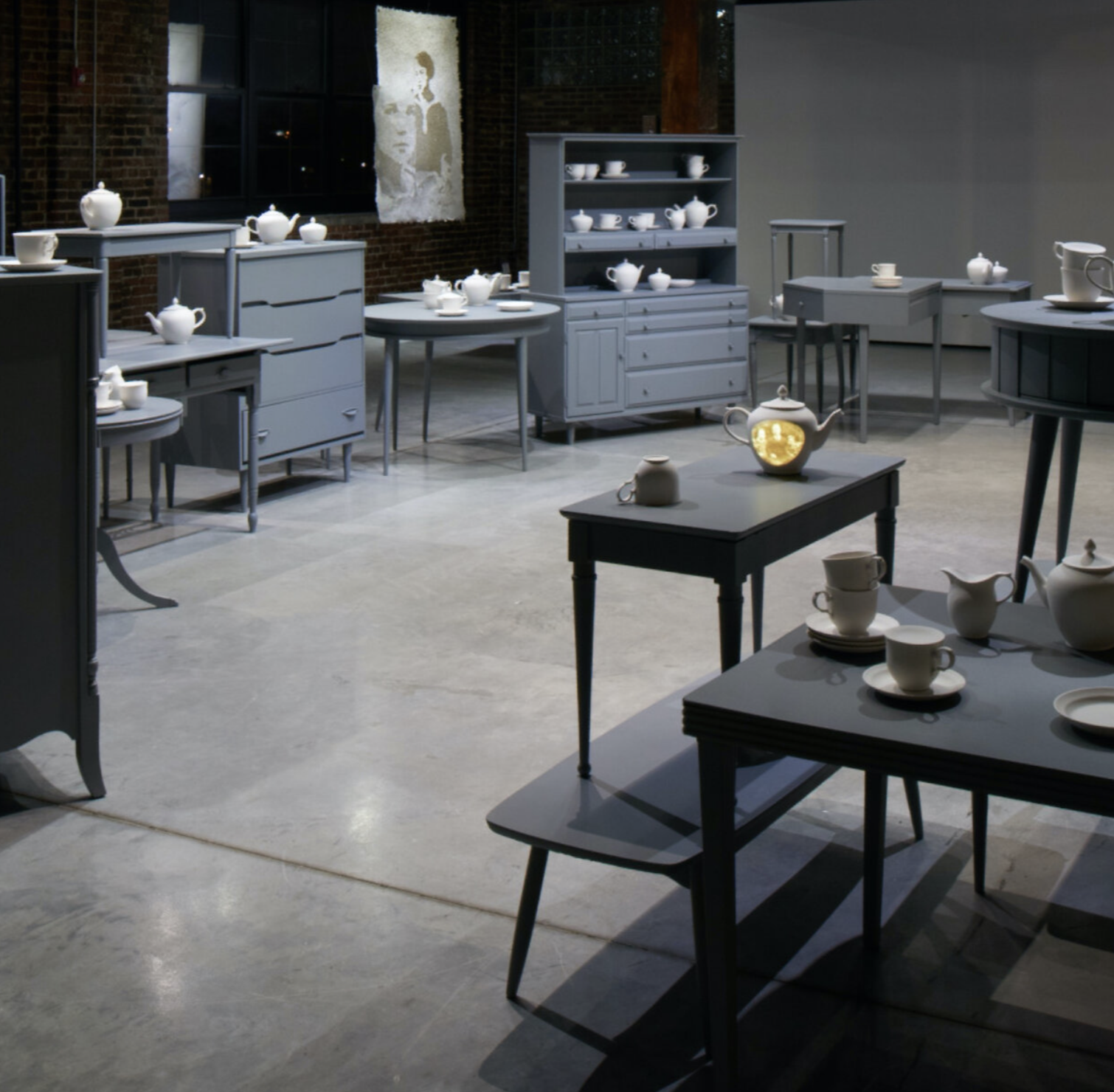
"When we receive something from a family member, we carry a cherished memory within it. But then the difficulty is, when we pass it down to another younger member of our family, they will not necessarily receive the association to the memories unless we tell the story, unless we take on the responsibility to share the story that we received. And so, every time there is an exchange, it's not as though the complete narrative is passed down. It gets diluted throughout the years; unless a very powerful story is associated with it, and we take an active role in communicating the story."
It is in the act of giving and receiving that Rae's work, indeed, enters the realm of magical realism. As audience members approach Rae's work, they are welcomed into a gently lit, almost dim space with gray vintage furniture that further darkens the atmosphere. The grayness blurs the individuality of the objects. Muted and subdued, the space visually isolates the white porcelain groupings atop the gray tables, credenzas, and curio cabinets. At first glance, there is something mundane, "everyday life," or conventional. The unglazed porcelain of the dinnerware is buttery smooth and gently reflects the soft exhibition light. The glazeless porcelain, in the pacified space, beckons you to search for meaning and begs for interaction. Dare you touch it?
Patrons are encouraged and alerted that they are welcome to touch the objects before entering the exhibition space, but there is something intimate in the raw forms – delicate and fragile.
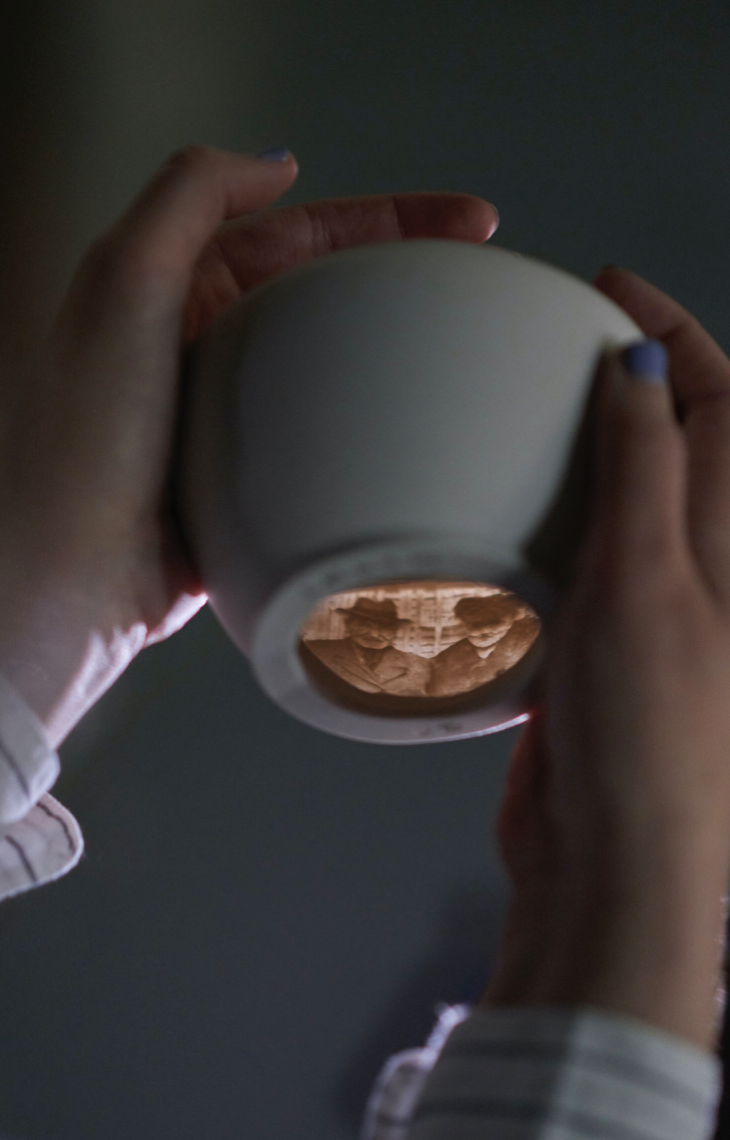 Parallel to pulling memory from your mind's eye, and if you touch the vessels, a static image, a portrait, illuminates from the porcelain surface. No sooner have you begun to realize the porcelain is glowing in your hands than it begins to fade.
Parallel to pulling memory from your mind's eye, and if you touch the vessels, a static image, a portrait, illuminates from the porcelain surface. No sooner have you begun to realize the porcelain is glowing in your hands than it begins to fade.
This seemingly ordinary space is an interactive experience. Propelled by your touch, the porcelain momentarily reveals frozen moment narratives. The moment is fleeting, though. Tiny evanescent memories of the lives of people – people who you can see yourself within, who you can relate to, who you can project your family experience onto – act as the catalyst for this social practice experience.
Activated by your touch, the porcelain unveils its secret – it was a silent witness.
A witness to the joy and life lived within a home – common to all homes – as well as a witness to the systematic displacement of families – as experienced by Jewish families. There is an unspoken tension between universality and individualism.
When I asked Rae directly if she noticed if there was a deeper connection to her work from the people who have firsthand experiences with the Holocaust, for example, direct lineage by handing down heirlooms, versus the interaction of people who have general knowledge from their educational experience or documentary knowledge, she responded:
"I see different types of interaction; I just don't know that I would split it that way.
"In the early stages – when I started to meet with people, and I was just making; before there was an installation – there were a few instances where people just saw a photograph of the work and started crying. I had never expected that, not in a million years, and I don't want to make people cry, but it was also a good indication that there was something emotional here that was meeting people on their terms.
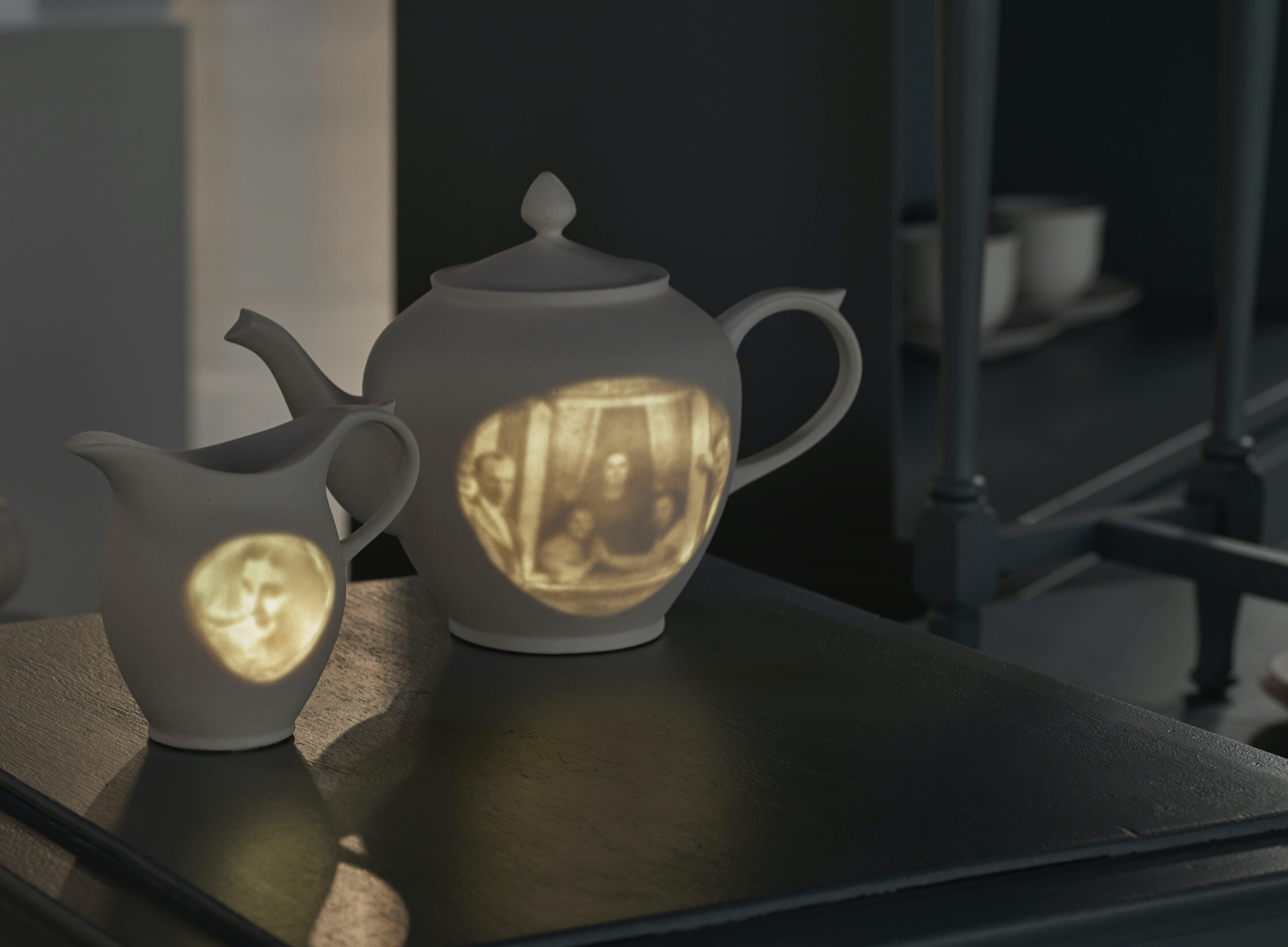 "Regardless of the circumstances or connections to the Jewish experience, the emotional response was often from people who had lost a parent. I think that is because the connection between a parent and child is where the passing down of objects to memory is present.
"Regardless of the circumstances or connections to the Jewish experience, the emotional response was often from people who had lost a parent. I think that is because the connection between a parent and child is where the passing down of objects to memory is present.
"Then there were other people that had experienced different kinds of loss, whether it was hurricanes, fires, or being a refugee or immigrant. From a very personal standpoint, they understood the meaning of an object, loss, and having a memory from a different place that is turned on by certain triggers. And consequently, like the art, as that memory blooms for a second, your memory gets flooded, and you have to shut it down. You have to, kind of, let it go and move on with your life or ask yourself how will you pass it on?"
While Rae had numerous stories that varied from high school students' budding curiosity to her assistant, Elinore Noyes's research on her own family, who harbored a teenage Jewish girl disguised as a live-in nanny, the point always circled back to the power of objects and the significance of displacement.
In an age quickly transitioning from analog to digital, and when a cell phone can hold hundreds of thousands of photos, it's hard not to wonder what will survive. What will hold value in the archives of our memories? What will be systematically sold off, and what object will we protect and instill our legacy or heritage upon? What narrative will be told, and what will be forgotten?
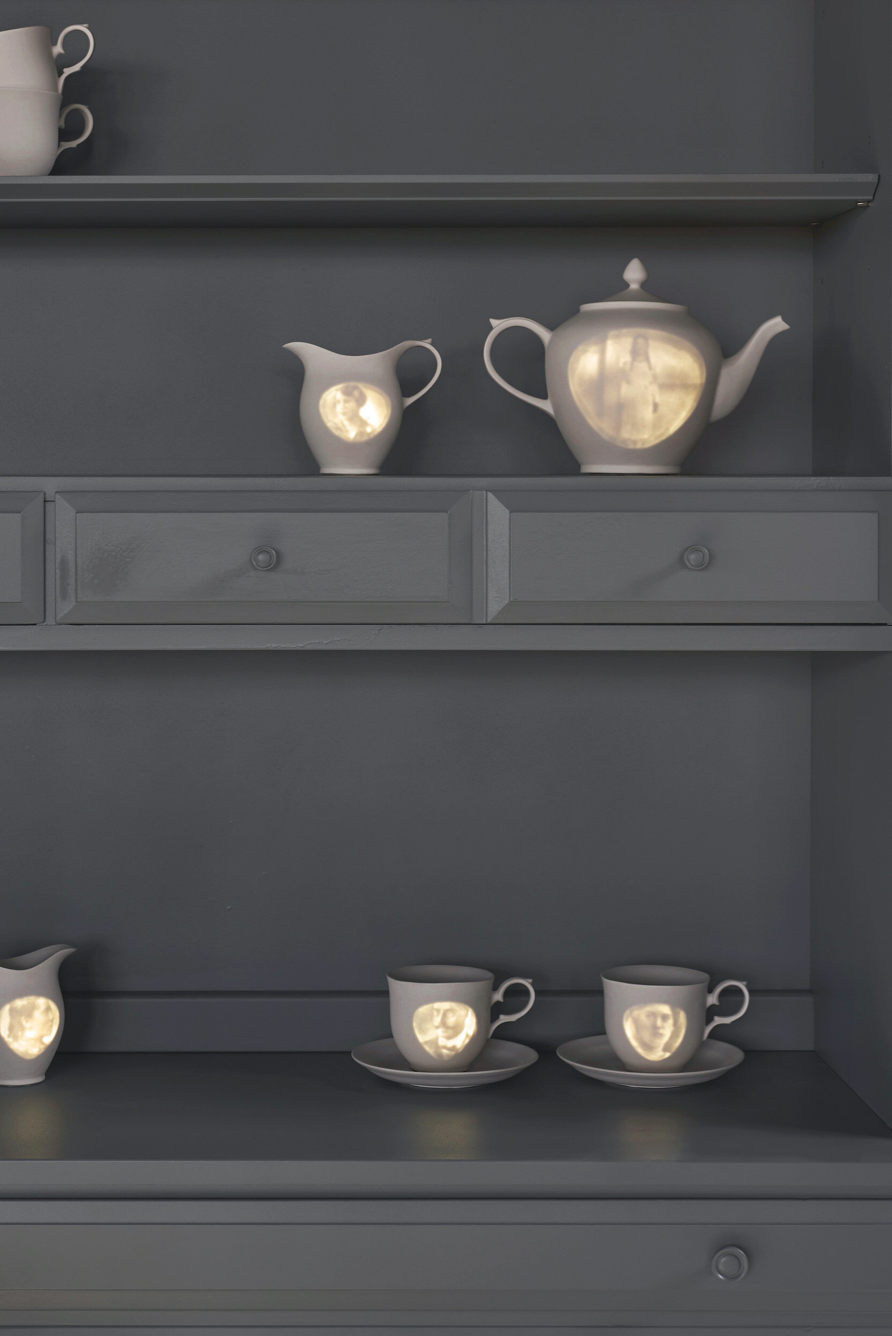 This, too, has been explored by Rae. Upon touching the porcelain objects, there is a rhythm to the excitement of discovery. In the search for each object to glow and reveal an intimate image or memory, it's disheartening to find that not all glow, not all flicker to life with the memories of the past. Part political and social critique, and part matter-of-fact narrative, if the story isn't passed down, if there's nobody to hand off the stories, if we don't take the responsibility of doing it, or if we don't ask, it's like we didn't touch the teapot. The objects need both the giver and receiver, or it
This, too, has been explored by Rae. Upon touching the porcelain objects, there is a rhythm to the excitement of discovery. In the search for each object to glow and reveal an intimate image or memory, it's disheartening to find that not all glow, not all flicker to life with the memories of the past. Part political and social critique, and part matter-of-fact narrative, if the story isn't passed down, if there's nobody to hand off the stories, if we don't take the responsibility of doing it, or if we don't ask, it's like we didn't touch the teapot. The objects need both the giver and receiver, or it
is displaced from memory; unable to bring back the story.
This inter-reliant relationship is at the heart of both Rae's social practice and her association with the magical realism genre. While the product of social practice art is translated using a variety of disciplines (art, activism, journalism, anthropology, and community outreach) and can be seen as a performance, activism, or material-based, the bottom line is that social practice maintains the idea of approaching a problem, rather than representing or exposing it. Rae's partnerships with Belger Arts, the Midwest Center for Holocaust Education, and local communities have perfectly positioned her to form meaningful connections. Even more significant is the context of creating work in Kansas City, where in 2014 there was a white-supremacist attack on the Jewish community.
Rae used the open access of her Belger Crane Yard Studio to interact with visitors and discuss the conceptual intentions behind her artwork in light of the current marginalization and persecution of communities around the world. Marginalization and underrepresentation are areas Rae set out to engage with and perhaps validate while engaging with the public. Rae reflects, "Holding these exchanges in a time of geopolitical unrest served my aim to create artwork with layered meaning."
Capturing the mysteriousness and uncanniness of everyday reality also perfectly positions Rae in the realm of magical realism. The genera emphasizes how implausible and strange normal objects can appear when you stop to consider their metaphoric and literal power while imbuing the objects or stories with an implicit critique of society.
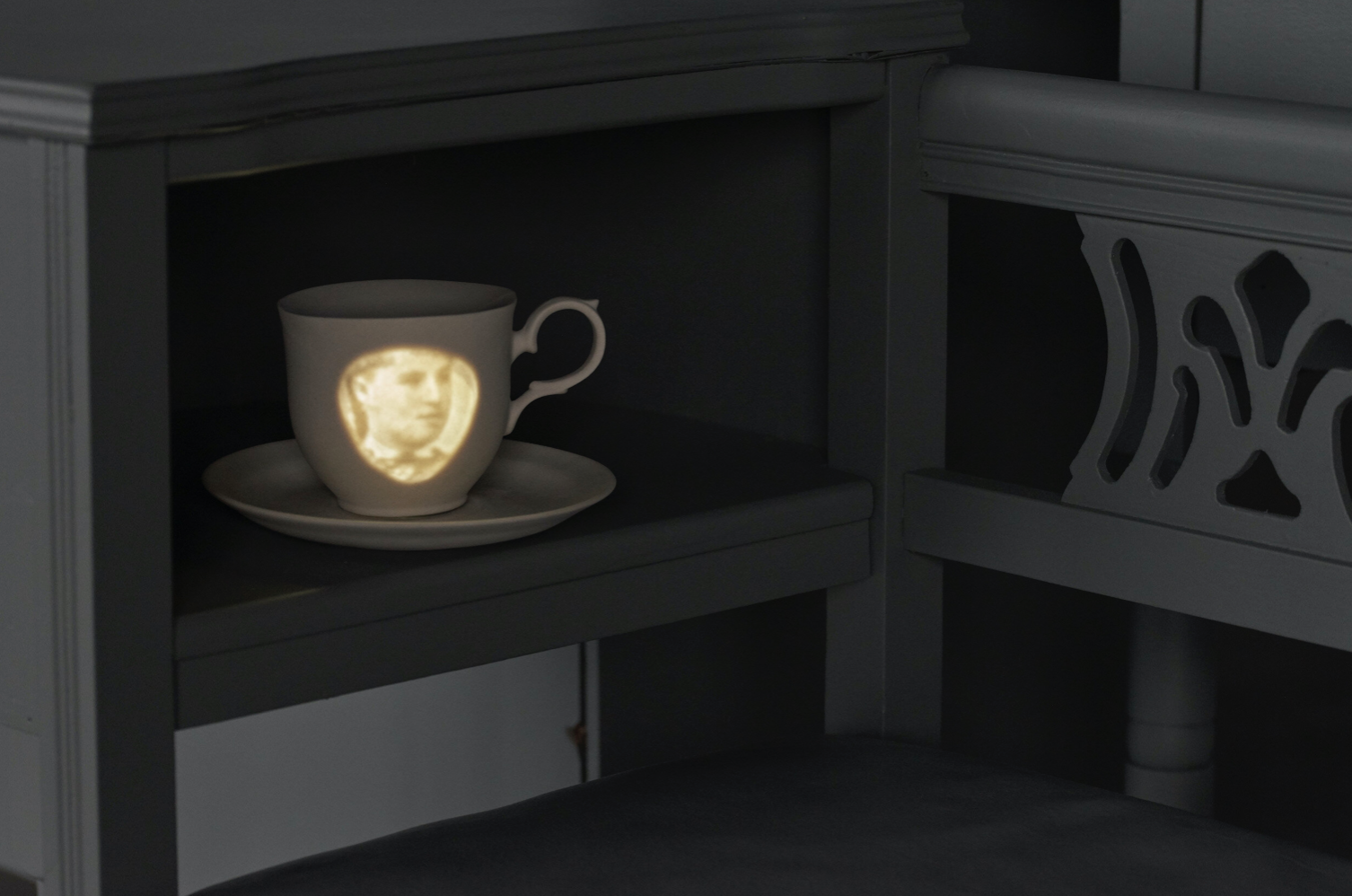 Rae: "When I had this idea on memory – touching and bringing back the memory – the initial inspiration wasn't motivated by the Holocaust. I wanted to make work about memory. I was recovering from a traumatic brain injury at the same time as the 2016 primaries. There were voices of fascism back in the public discourse. I thought we had learned about this in history; we know this is wrong, and we know this is a slippery slope. Yet here it is all over again.
Rae: "When I had this idea on memory – touching and bringing back the memory – the initial inspiration wasn't motivated by the Holocaust. I wanted to make work about memory. I was recovering from a traumatic brain injury at the same time as the 2016 primaries. There were voices of fascism back in the public discourse. I thought we had learned about this in history; we know this is wrong, and we know this is a slippery slope. Yet here it is all over again.
"I thought to myself, "I am working so hard to bring back my memory, but society is allowing itself to forget a fundamental lesson that wasn't so long ago in history." It was this desire to make a critique on the importance of not forgetting, that merged the technical idea with the conceptual meaning.”
Here is where Rae's work comes full circle. Through the lens of unconscious bias, it is easy to feel as though memorializing is a sufficient means of both honoring the victims and remembering the cruel acts of humanity. Yet, the dangers that confront our coming century are the conversation of "one without the other," conversations that continue to propagate linear narratives, and conversations that only see victims as the unfortunate few.
In Rae's words, "I defy the hierarchy between personal and anonymous memories. By embedding these memories in teaware, designed to reference mass production, and placing them as a continuum in space, I allude to their role in a larger, collective memory. I made it difficult to decipher where one family's story begins and another one's ends.
"Memory is an important factor in the formation of a sense of identity, but my dealing with the past is not nostalgic. Our past is often riddled with complex and painful personal recollections, even without trauma. These memories define us in subtle yet substantial ways and then continue to transform us in the process of recollection. In some ways, allowing the past to find its place in the past can make room for the present to take precedence and for the future to set the course."
Rae’s work is half cautionary tale and half contemporary critique, and there are no unfortunate few; we are all united in the experience. These ceramic vessels are a soft but urgent rallying cry about the need for us to come together and create the future we need. This is a protest against the mindset of “It’s only them, and not us.” Because it can be everybody and because it needs to be all of us. The contemporary silent witness sees our communal experience and will tell our stories, transforming one of the darkest times of human history into something galvanizing. But, this is only possible when we respond to the linear narratives – that continue to unfold today – and when we take the time to reach out to set a course for a more meaningful coexistence and more dignified future.
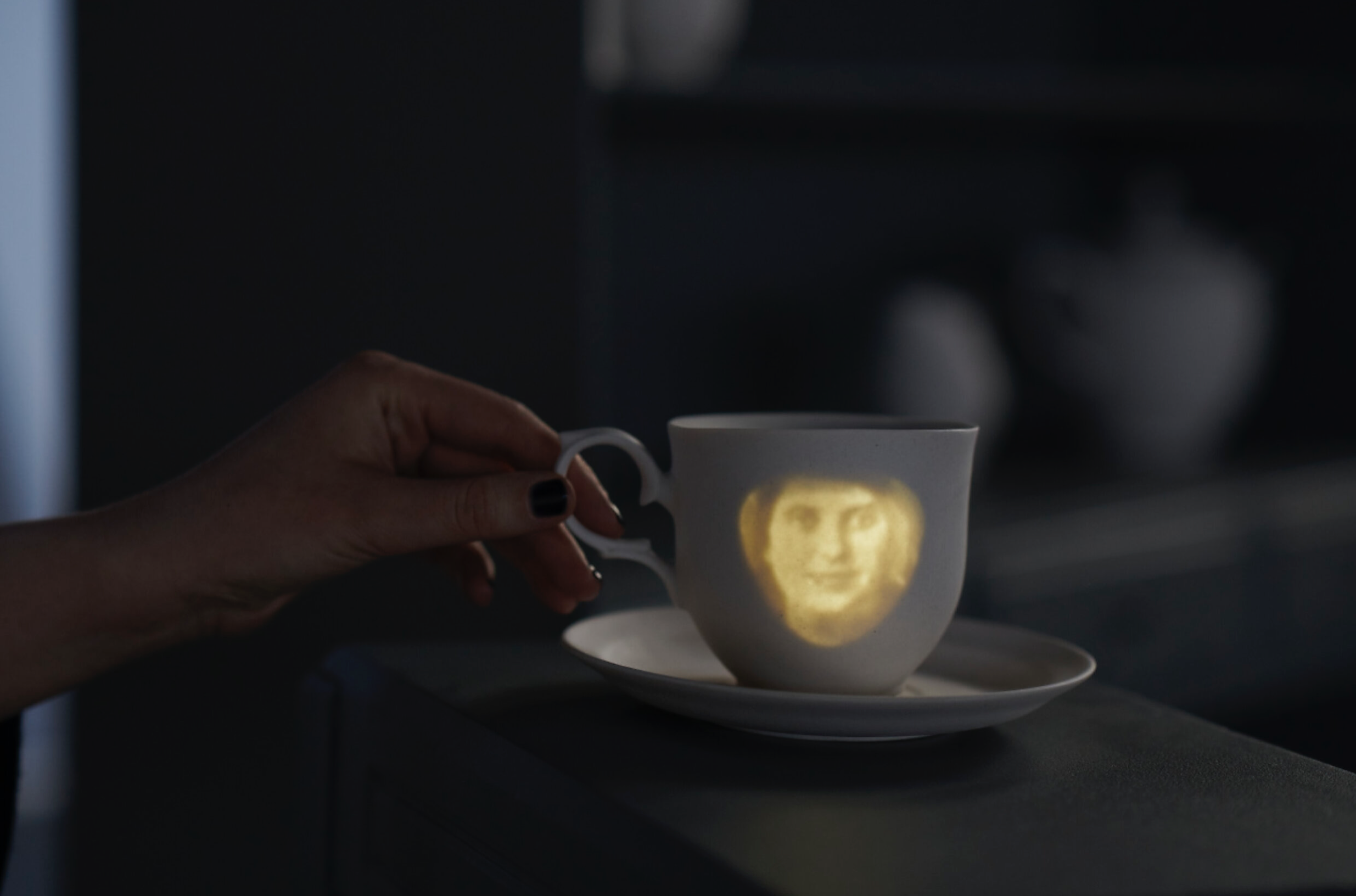
About Rae Stern
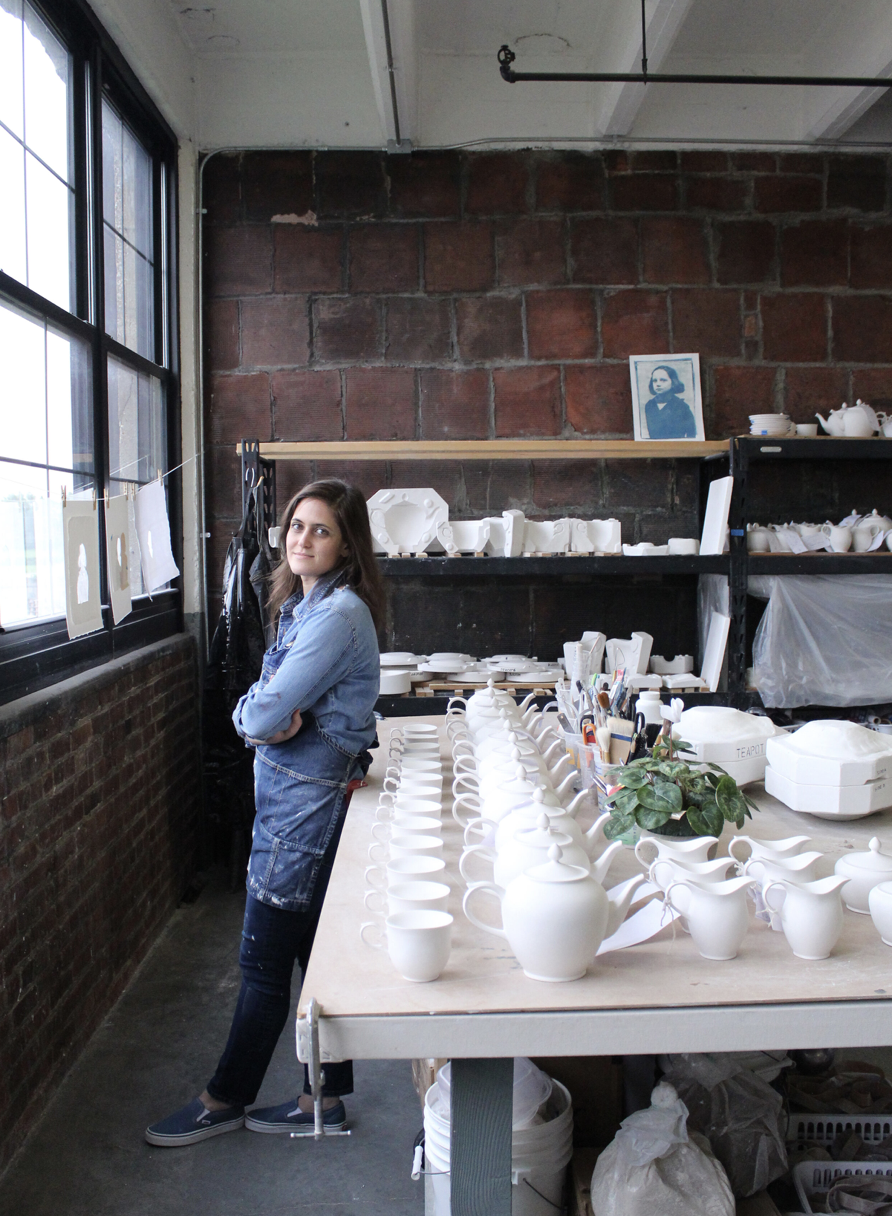 Rae Stern’s practice employs digital tools in the manipulation of multiple media including ceramics, photography, paper, and textiles. After a decade in the high-tech industry, her work is concerned with the social and cultural effects of technology. Between 2009 and 2018, Stern collaborated with Aya Margulis under the name Doda Design and created several bodies of work. She has attended residencies at Anderson Ranch, and Belger Crane Yard Studios, as well as received training at the Penland School of Crafts, Greenwich House Pottery, and the 92nd St.Y ceramics studios. Stern has received grants from Asylum Arts, Belger Arts, and Englewood Arts.
Rae Stern’s practice employs digital tools in the manipulation of multiple media including ceramics, photography, paper, and textiles. After a decade in the high-tech industry, her work is concerned with the social and cultural effects of technology. Between 2009 and 2018, Stern collaborated with Aya Margulis under the name Doda Design and created several bodies of work. She has attended residencies at Anderson Ranch, and Belger Crane Yard Studios, as well as received training at the Penland School of Crafts, Greenwich House Pottery, and the 92nd St.Y ceramics studios. Stern has received grants from Asylum Arts, Belger Arts, and Englewood Arts.
Stern’s work has been exhibited at the Virginia Museum of Contemporary Art (Virginia Beach, VA), Eretz Israel Museum, (Tel Aviv, Israel), Belger Arts, (Kansas City, MO), Harvard University, (Cambridge, MA), and Medalta Museum, (Alberta, Canada). Her work is included in the collections of the Racine Art Museum (Racine, WI), The International Museum of Dinnerware Design (Ann Arbor, MI), The Eretz Israel Museum, (Tel Aviv, Israel), as well as numerous private collections in Israel and the US. Stern completed her undergraduate degree in psychology and communications at Tel Aviv University, followed by a master’s degree in design from the Bezalel Academy of Art and Design, Jerusalem.

